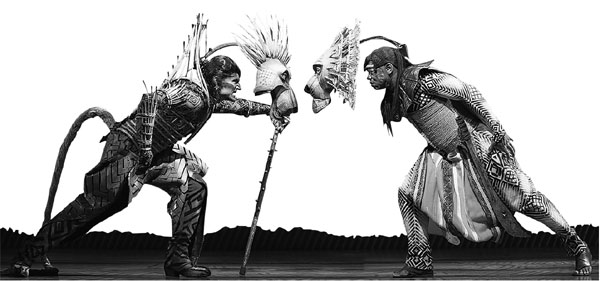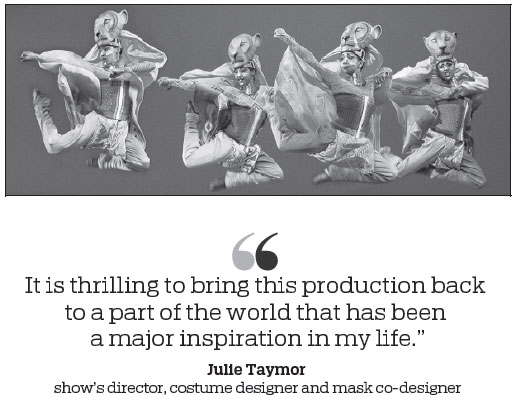Roaring back to China
Theatergoers and Disney fans are in for a treat when The Lion King musical returns to Chinese shores next year
When Michael Eisner, then chairman and chief executive officer of The Walt Disney Company, initiated the idea of turning the animated film, The Lion King, into a musical, Thomas Schumacher, the president of Disney Theatrical Group, the theatrical production arm of The Walt Disney Company, thought it was a bad idea.
When the animated film was released in 1994, Disney Theatrical Group premiered its first Broadway musical, Beauty and the Beast, which received mixed reviews from the critics.
"We don't need another beast," Schumacher told Eisner.


However, since its Broadway premiere on Nov 13, 1997, the musical, The Lion King, has been staged for 22 years and has been translated into eight languages, attracting more than 100 million people from 20 countries. It won six Tony Awards in 1998, including those for Best Musical, Best Choreography and Best Costume Design.
In March 2018, in celebration of The Lion King musical's 20th anniversary, the production launched an international tour, which premiered in Manila, Philippines.
Next year, the musical will tour to China, playing in both Wuhan and Beijing for the first time.
The Lion King will open the tour with more than 70 shows at Wuhan's Qintai Grand Theatre, beginning on Feb 19, 2020. The show will then open at Beijing's Poly Theatre on May 6, 2020, where it is set to embark on a run of 200 performances.
"We have previously spent time in China with Disney's first production of The Lion King in 2006, with 101 performances at the Shanghai Grand Theater. I'm thrilled to return to China and with each performance, we will give greater life to Julie Taymor's incredible vision on stage. I cannot wait for new audiences to join us," says producer of the musical, Michael Cassel, who was in Beijing to announce the China tour, in collaboration with local partners, Seven Ages Musical and Beijing Poly Theatre Management Co Ltd.
According to Felipe Gamba, director of international production strategy for Disney Theatrical Group, the musical will bring a global cast and crew of over 100 people representing 19 nationalities to China. Amanda Kunene, who was born in Durban, South Africa, and Jordan Shaw from the UK play Nala and Simba, respectively.
Besides real actors and actresses, there will be puppets, masks and costumes, which will take audiences to the tropical rainforest, desert and the grasslands of the African savanna as part of the classic Disney story.
Based on the 1994's animated film, the musical tells the tale of a young lion called Simba on his path to succeeding his father, Mufasa, as king.
The score features the music of Elton John and Tim Rice from The Lion King animated film, along with three new songs by John and Rice as well as additional musical material, which is a fusion of Western popular music and the distinctive sounds and rhythms of Africa.
When Gamba recalls the origin of the musical production, he says that when Julie Taymor, show's director, costume designer and mask co-designer, was first approached by Schumacher to direct and design a stage adaptation of The Lion King, and she had not yet seen the blockbuster film.
When she finally did watch it, the stampede scene was the one that cemented her decision to adapt it for the stage, even though she had no idea how she would eventually manage it.
"The challenge is always the thing that gets me excited. I want to know how I'm going to do something," she says, adding that Asia is a big part of her life, after once spending four years in Indonesia and traveling extensively throughout the region.
"It is thrilling to bring this production back to a part of the world that has been a major inspiration in my life," she adds.
The human beings that control the puppets and wear the animal masks are fully seen onstage. Taymor didn't hide the real actors and actresses because "as an audience member at The Lion King musical you have an important job: With your imagination, you are invited to mix the 'animal' with the human beings into a magical whole".
There are different kinds and sizes of puppets. For example, Zazu, the king's most trusted adviser, is a classical hand puppet and Timon, a wisecracking meerkat and the best friend of Pumbaa, a warthog, is based on the Japanese bunraku puppet.
"When the human spirit visibly animates an object, we experience a special, almost life-giving connection. Real human actors and puppets create the movements onstage together.
We become engaged by both the method of storytelling as well as the story itself," she says.
The most dramatic scene in the musical is the stampede scene in which Mufasa is killed. The effect in the theater is electric, as thousands of wildebeests seem to be rushing straight at Simba and at the audience.
The illusion of thousands of racing animals is achieved with a canvas scroll and a series of large rollers, which was created by Taymor and set designer Richard Hudson. Wildebeests are painted on the scroll, and each roller is equipped with sculptures of the animals.
On each successive roller, the wildebeest sculptures are slightly larger, until, closest to the audience, dancers rhythmically move huge wildebeest masks.
This design creates a false perspective of great distance. When the scroll and rollers are moving, the audience seems to see waves of wildebeests driving forward.
chennan@chinadaily.com.cn
|
Next year, the musical The Lion King will tour to China, playing in both Wuhan and Beijing for the first time. Photos Provided to China Daily |
(China Daily Global 11/26/2019 page15)



















